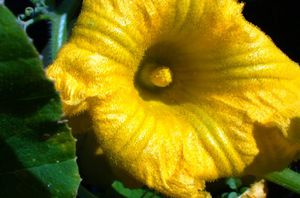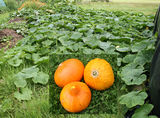Pumpkin
| Pumpkin | |
|---|---|

| |
| Pumpkin flower | |
| Scientific classification | |
| Kingdom: | Plantae |
| Order: | Cucurbitales |
| Family: | Cucurbitaceae |
| Species: | Cucurbita |
Already between 9000 and 7000 BCE, pumpkins were grown in Central and South America. The pumpkin was first introduced in Europe in the 16th century.
Pumpkins are a warm-weather crop that is usually planted in early July. Soil temperatures should at least be 60 F (15.5 C). The soil should be well drained and provide enough water and preferably many nutrients. I usually grow my pumpkin plants on an old compost heap and there they do extremely well.
Pumpkins are used for traditional dishes such as pumpkin pie and pumpkin bread. The seeds can be roasted and eaten. Also the young stem tips and flowers are edible. In Mexico the flower is often used to decorate dishes. The flowers have a sweet flavor. They can be fried inside a layer of dough.
Pumpkin seeds have many health benefits as they are a good source of protein, several minerals and vitamins. Pumpkin oil is a thick oil with a robust flavor that is produced from roasted pumpkin seeds. It is long believed to be a folk remedy for prostrate problems.
Pumpkins are said to be anti-diabetic, anti-oxidant, anti-carcinogenic and anti-inflammatory.
Garden Journal
- See also Garden Journal for a list with all plants with a garden journal section.
May 19, 2012 - The danger for night frost is over so time to plant out warmth-loving crops. I have this big compost heap that i don't need to use in the coming season. It's the perfect place for growing pumpkins and similar plants such as cucumber and melon. So i planted two pumpkin plants on the south slope of the compost heap. Pumpkins and cucumbers and melons belong to the gourd family (Cucurbitaceae) and they all like much sun and a humus-rich soil with lots of nutrients. Just one pumpkin or cucumber plant can either give you a big harvest or entirely disappoint you when the conditions or the weather aren't right.
August 11, 2012 - The two Uchiki kuri pumpkin plants that i planted on May 19 have grown very well and their branches and leaves now occupy an area of 80 m2. I harvested the first fruits. They These two plants have grown very well and their branches and leaves now occupy an area of 80 m2. I harvested the first fruits. They taste delicious and many weigh more than 3 kg.
Uchiki kuri
Uchiki kuri = Red kuri squash. Inside the hard outer skin there is a firm flesh that provides a very delicate and mellow chestnut-like flavor. Red kuri is widely adapted for climates that provide a growing season of 100 days or more. Red kuri squash is a perfect ingredient for a variety of soups, stews and casseroles. Red kuri squash is a good source of fiber. It also provides vitamin A and vitamin C, some of the B vitamins, calcium, potassium, iron, riboflavin and thiamine. Low in calories and sodium, this deep-colored squash also contains beta-carotene.[1]
Gallery
References
External links
- Pumpkin Wikipedia




